Dock Window in Windows Forms Docking Manager
4 Feb 202520 minutes to read
The docking manager allows you to dock the control on any of the four sides of the container control, and provides docking hints while dragging the panel over it. This preview will provide information about how the layout will look after dropping the panel to dock.

Enable/disable dock functionality
The docking functionality can be enabled or disabled by setting the Boolean value as true or false in the SetEnableDocking function.
//To enable the docking functionality.
this.dockingManager1.SetEnableDocking(this.panel1, true);
this.dockingManager1.SetEnableDocking(this.panel2, true);
this.dockingManager1.SetEnableDocking(this.panel3, true);
this.dockingManager1.SetEnableDocking(this.panel4, true);'To enable the docking functionality.
Me.dockingManager1.SetEnableDocking(Me.panel1, True)
Me.dockingManager1.SetEnableDocking(Me.panel2, True)
Me.dockingManager1.SetEnableDocking(Me.panel3, True)
Me.dockingManager1.SetEnableDocking(Me.panel4, True)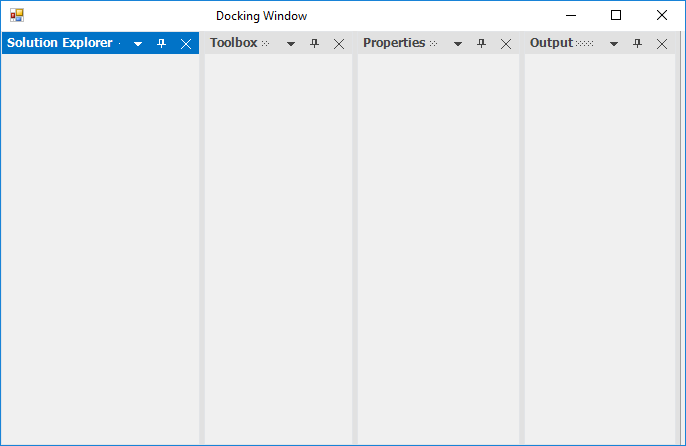
Change dock side of children
The docking manager allows you to specify the docking type and bounds of the docked control using the DockControl function.
The following are the five sides that can be docked by the control:
- Left
- Right
- Top
- Bottom
- Tabbed
- Fill
this.dockingManager1.DockControl(this.panel1, this, Syncfusion.Windows.Forms.Tools.DockingStyle.Bottom, 100);
this.dockingManager1.DockControl(this.panel2, this, Syncfusion.Windows.Forms.Tools.DockingStyle.Right, 100);
this.dockingManager1.DockControl(this.panel3, this.panel2, Syncfusion.Windows.Forms.Tools.DockingStyle.Tabbed, 100);
this.dockingManager1.DockControl(this.panel4, this, Syncfusion.Windows.Forms.Tools.DockingStyle.Left, 100);Me.dockingManager1.DockControl(Me.panel1, Me, Syncfusion.Windows.Forms.Tools.DockingStyle.Bottom, 100)
Me.dockingManager1.DockControl(Me.panel2, Me, Syncfusion.Windows.Forms.Tools.DockingStyle.Right, 100)
Me.dockingManager1.DockControl(Me.panel3, Me.panel2, Syncfusion.Windows.Forms.Tools.DockingStyle.Tabbed, 100)
Me.dockingManager1.DockControl(Me.panel4, Me, Syncfusion.Windows.Forms.Tools.DockingStyle.Left, 100)
Dock window to another window
Provides support to dock a window inside another window with the help of drag providers. This can be done programmatically by using the DockControl function.

this.dockingManager1.DockControl(this.panel4, this.panel1, Syncfusion.Windows.Forms.Tools.DockingStyle.Tabbed, 100);Me.dockingManager1.DockControl(Me.panel4, Me.panel1, Syncfusion.Windows.Forms.Tools.DockingStyle.Tabbed, 100)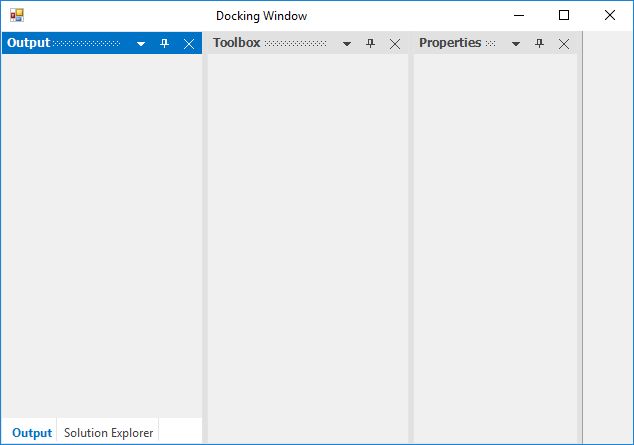
Detect dock style
Docking style that is assigned to the control can be detect at run time using the GetDockStyle function.
MessageBox.Show("Dock style :" + this.dockingManager1.GetDockStyle(this.panel1));MessageBox.Show("Dock style :" + Me.dockingManager1.GetDockStyle(Me.panel1))Change dock window header
The SetDockLabel function helps to set the label for a child window.
// To set the label for the docked controls
this.dockingManager1.SetDockLabel(panel1, "New");' To set the label for the docked controls
Me.dockingManager1.SetDockLabel(panel1, "New");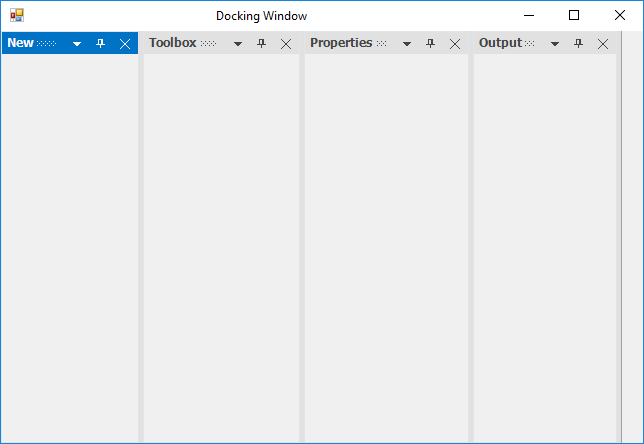
Change dock window size
Dock panel size can be resized at run time using the splitters between the dock panels. The docking manager provides a way to change the size of dock panels by programmatically. The SetControlSize function of docking manager helps to set the size of docked control. The GetControlSize function of docking manager helps to get the size of dock panel.
//Get the size of docked or Floating control using the GetControlSize function.
this.dockingManager1.GetControlSize(this.panel2);
Console.Write("Size" + this.dockingManager1.GetControlSize(this.panel2));
//Set the size of docked or Floating control using the GetControlSize function.
this.dockingManager1.SetControlSize(this.panel1, new Size(200, 200));'Get the size of docked or Floating control using the GetControlSize function.
Me.dockingManager1.GetControlSize(this.panel2)
Console.Write("Size" + Me.dockingManager1.GetControlSize(Me.panel2))
'Set the size of docked or Floating control using the GetControlSize function.
Me.dockingManager1.SetControlSize(this.panel1, new Size(200, 200))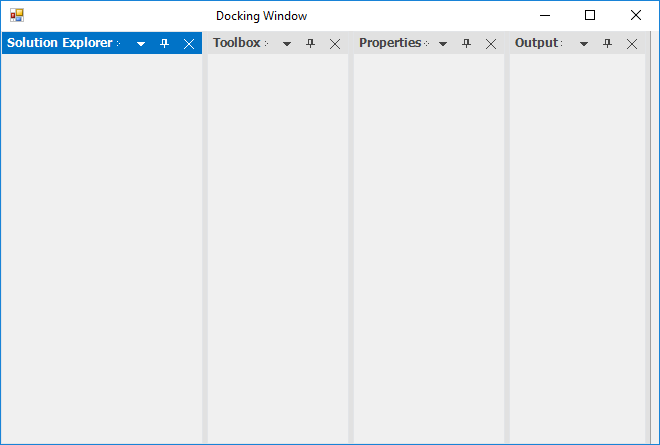
Add icon in header of dock window
The caption icons/images can be set by using the SetDockIcon function of the docked control. This behavior can be enabled or disabled by using the ShowCaptionImages property. Its default value is true. To hide the caption image, set the ShowCaptionImages property to false.
| Functions | Description |
|---|---|
| SetDockIcon(Control, Icon) | Sets the icon or image for the docking window by passing the image icon as a parameter for this function. Control represents the dock enabled control, and the image icon represents the docking window. |
| SetDockIcon(Control, Int32) | This overloaded function returns the index of image associated with the docking window. Control indicates the docking window, and the Int32 represents a zero-based index to the ImageList property value. |
System.Drawing.Icon icon = new System.Drawing.Icon(GetIconFile(GetIconFile(@"..\\..\\\$this.Icon.ico")));
private string GetIconFile(string bitmapName)
{
for (int n = 0; n < 10; n++)
{
if (System.IO.File.Exists(bitmapName))
return bitmapName;
bitmapName = @"..\" + bitmapName;
}
return bitmapName;
}
this.dockingManager1.ShowCaptionImages = true;
this.dockingManager1.SetDockIcon(this.panel1, icon);Dim icon As System.Drawing.Icon = New System.Drawing.Icon(GetIconFile(GetIconFile("..\\..\\\$this.Icon.ico")))
Private Function GetIconFile(ByVal bitmapName As String) As String
For n As Integer = 0 To 9
If System.IO.File.Exists(bitmapName) Then
Return bitmapName
End If
bitmapName = "..\" & bitmapName
Next n
Return bitmapName
End Function
Me.dockingManager1.ShowCaptionImages = True
Me.DockingManager1.SetDockIcon(Me.panel1, icon)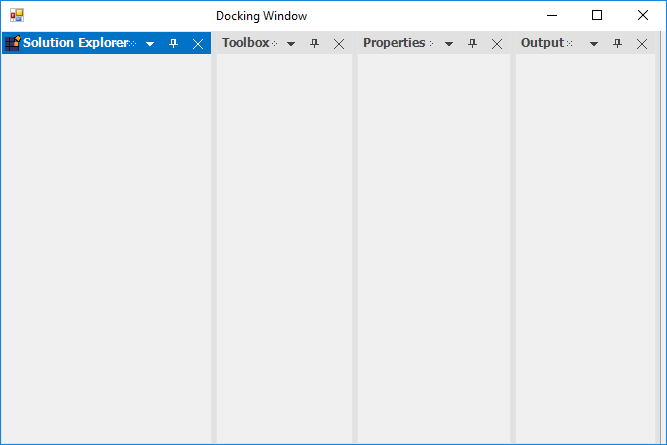
Change caption label alignment
The DockLabelAlignment property helps to align the caption label to left, right, and center position in the docking manager.
this.dockingManager1.DockLabelAlignment = DockLabelAlignmentStyle.Right;Me.dockingManager1.DockLabelAlignment = DockLabelAlignmentStyle.Right
Change visibility of caption buttons
The docking manager has following functions to retrieve and manipulate the buttons visibility in the CaptionBar.
-
SetCloseButtonVisibility: Shows/hides the close button in the caption bar of the particular window.
-
GetCloseButtonVisibility: Returns a bool value according to visibility of the close button.
-
SetAutoHideButtonVisibility: Shows/hides the AutoHide button in the caption bar of the particular window.
-
GetAutoHideButtonVisibility: Returns a bool value according to visibility of the AutoHide button.
-
SetMenuButtonVisibility: Shows/hides the menu button in the caption bar of the particular window.
-
GetMenuButtonVisibility: Returns a bool value according to the visibility of menu button.
The following code demonstrates the usage of these functions:
this.dockingManager1.SetCloseButtonVisibility(this.panel1, false); //true to show again
this.dockingManager1.GetCloseButtonVisibility(this.panel1); //true when button is visible, false otherwise.Me.dockingManager1.SetCloseButtonVisibility(Me.panel1, False) 'true to show again
Me.dockingManager1.GetCloseButtonVisibility(Me.panel1) 'true when button is visible, false otherwise.
Show/hide dock windows
The SetDockVisibility function helps to set the visibility of docked control, and the GetDockVisibility helps to identify the visibility of docked control.
this.dockingManager1.SetDockVisibility(this.panel1, false);
Console.Write("DockWindow Visibility" + this.dockingManager1.GetDockVisibility(this.panel1));Me.dockingManager1.SetDockVisibility(Me.panel1, False)
Console.Write("DockWindow Visibility" + Me.dockingManager1.GetDockVisibility(Me.panel1))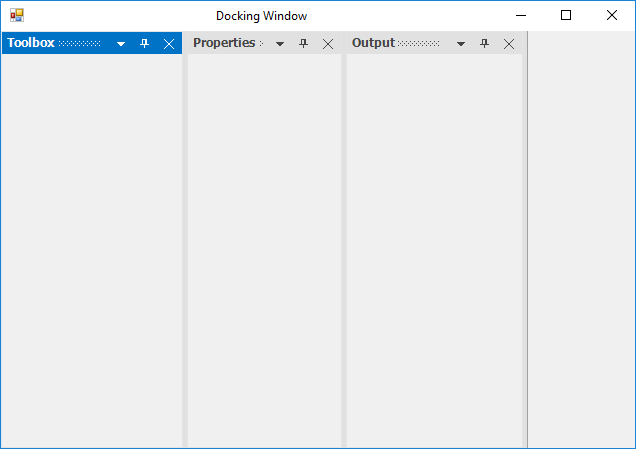
Add custom buttons in caption
The Custom Caption Collection Editor can be accessed by using the DockingManager. CaptionButtons property allows you to customize the default buttons and to add new custom caption buttons.
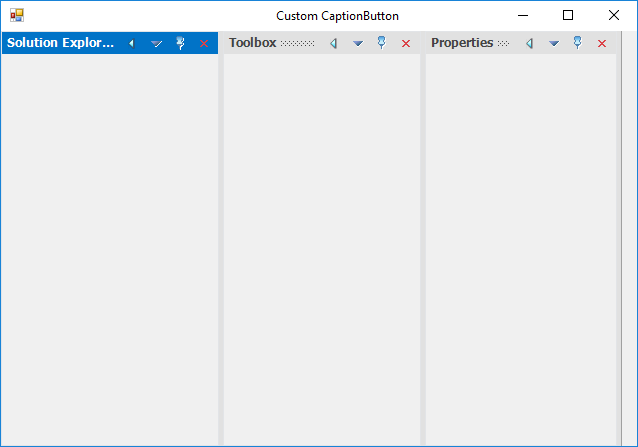
In the CaptionButtons Collection Editor, you can add the new caption button by clicking Add.
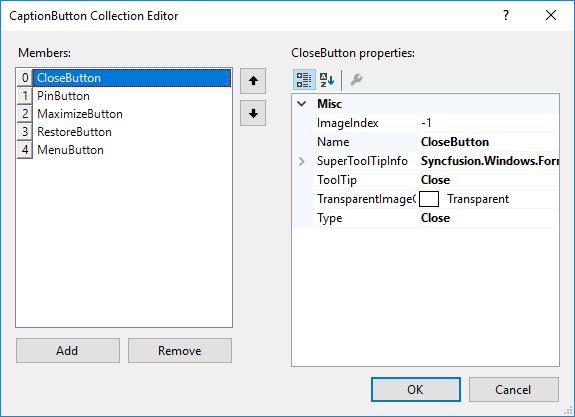
This can also be done programmatically by using the following code examples.
this.dockingManager1.ImageList = imageList;
Syncfusion.Windows.Forms.Tools.CaptionButton captionButton = new Syncfusion.Windows.Forms.Tools.CaptionButton();
Syncfusion.Windows.Forms.Tools.ToolTipInfo toolTipInfo = new Syncfusion.Windows.Forms.Tools.ToolTipInfo();
captionButton.ImageIndex = 3;
captionButton.Name = "Custom Button";
captionButton.Type = Syncfusion.Windows.Forms.Tools.CaptionButtonType.Custom;
captionButton.SuperToolTipInfo = toolTipInfo;
captionButton.TransparentImageColor = System.Drawing.Color.Transparent;
this.dockingManager1.CaptionButtons.Add(captionButton);
Syncfusion.Windows.Forms.Tools.CaptionButton captionButton1 = new Syncfusion.Windows.Forms.Tools.CaptionButton();
Syncfusion.Windows.Forms.Tools.ToolTipInfo toolTipInfo1 = new Syncfusion.Windows.Forms.Tools.ToolTipInfo();
captionButton1.ImageIndex = 0;
captionButton1.Name = "CloseButton";
captionButton1.Type = Syncfusion.Windows.Forms.Tools.CaptionButtonType.Close;
captionButton1.SuperToolTipInfo = toolTipInfo1;
captionButton1.TransparentImageColor = System.Drawing.Color.Transparent;
this.dockingManager1.CaptionButtons.Add(captionButton1);Me.dockingManager1.ImageList = imageList
Dim captionButton As Syncfusion.Windows.Forms.Tools.CaptionButton = New Syncfusion.Windows.Forms.Tools.CaptionButton()
Dim toolTipInfo As Syncfusion.Windows.Forms.Tools.ToolTipInfo = new Syncfusion.Windows.Forms.Tools.ToolTipInfo()
captionButton.ImageIndex = 3
captionButton.Name = "Custom Button"
captionButton.Type = Syncfusion.Windows.Forms.Tools.CaptionButtonType.Custom
captionButton.SuperToolTipInfo = toolTipInfo
captionButton.TransparentImageColor = System.Drawing.Color.Transparent
Me.dockingManager1.CaptionButtons.Add(captionButton)
Dim captionButton1 As Syncfusion.Windows.Forms.Tools.CaptionButton = New Syncfusion.Windows.Forms.Tools.CaptionButton()
Dim toolTipInfo1 As Syncfusion.Windows.Forms.Tools.ToolTipInfo = new Syncfusion.Windows.Forms.Tools.ToolTipInfo()
captionButton1.ImageIndex = 0
captionButton1.Name = "CloseButton"
captionButton1.Type = Syncfusion.Windows.Forms.Tools.CaptionButtonType.Close
captionButton1.SuperToolTipInfo = toolTipInfo1
captionButton1.TransparentImageColor = System.Drawing.Color.Transparent
Me.dockingManager1.CaptionButtons.Add(captionButton1)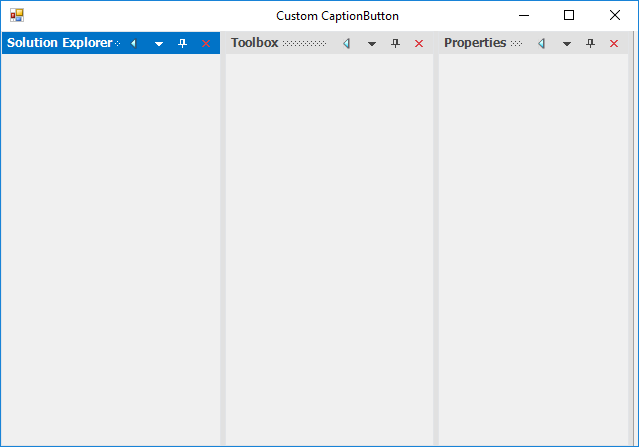
NOTE
Refer to the following sample link that demonstrates how to add the Custom Caption Buttons:
C:\Users\<User>\AppData\Local\Syncfusion\EssentialStudio\Version Number\Windows\Tools.Windows\Samples\Docking Manager\Custom Captions\CS
Customize caption buttons
The docking manager allows to customize the default caption buttons. The ForeColor of Active and Inactive window caption button can be customized by using the ActiveCaptionButtonForeColor and InActiveCaptionButtonForeColor properties.
this.dockingManager1.ActiveCaptionButtonForeColor = System.Drawing.Color.Red;
this.dockingManager1.InActiveCaptionButtonForeColor = System.Drawing.Color.Green;Me.dockingManager1.ActiveCaptionButtonForeColor = System.Drawing.Color.Red
Me.dockingManager1.InActiveCaptionButtonForeColor = System.Drawing.Color.Green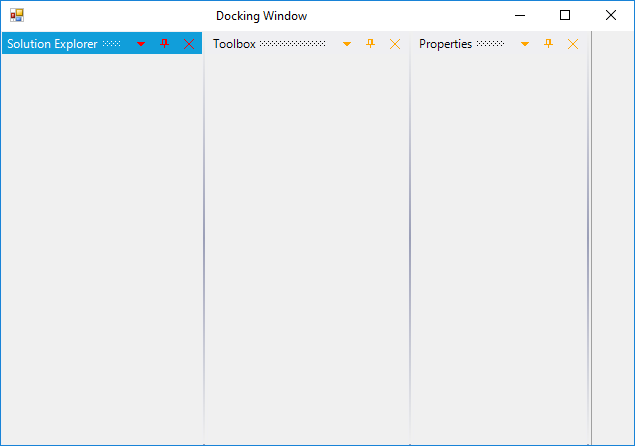
Change header visibility of dock window
The docking manager allows to change the visibility of caption for dock panels. The ShowCaption property helps to show or hide the caption of the DockPanel. Its default value is true. You can hide the caption, by setting the ShowCaption property to false.
//To disable the caption of the dock window.
this.dockingManager1.ShowCaption = false;'To disable the caption of the dock window.
Me.dockingManager1.ShowCaption = False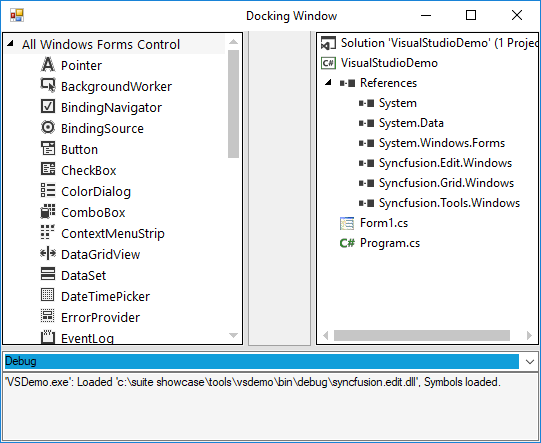
Maximize and restore
The docking manager supports to maximize and restore the dock windows by using the maximize button, so that a clear view of contents can be obtained. This can be enabled by setting the MaximizeButtonEnabled property to true.
this.dockingManager1.MaximizeButtonEnabled = true;Me.dockingManager1.MaximizeButtonEnabled = True
NOTE
The maximize button will be visible only if any other control is docked to the bottom of the former control.
Occupy whole window
The DockToFill property allows users to implement a unique docking layout where a non-MDIContainer form or ContainerControl’s entire client region is occupied by dockable controls.
this.dockingManager1.DockToFill = true;Me.dockingManager1.DockToFill = True;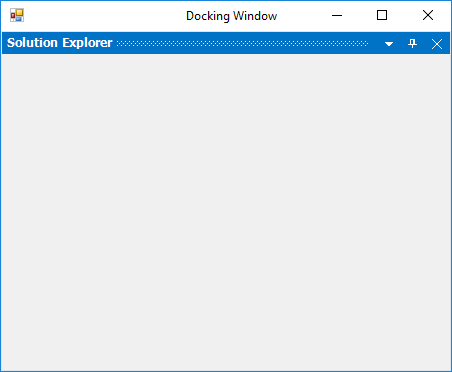
Enable/disable the context menu
A context menu will be displayed whenever users right-click the caption bar or click the menu button in the caption bar. You can show or hide the context menu of the docked window by using the EnableContextMenu property of docking manager. The default value of this property is true. To hide the context menu in docked windows, set the EnableContextMenu property to false.
this.dockingManager1.EnableContextMenu = true;Me.dockingManager1.EnableContextMenu = True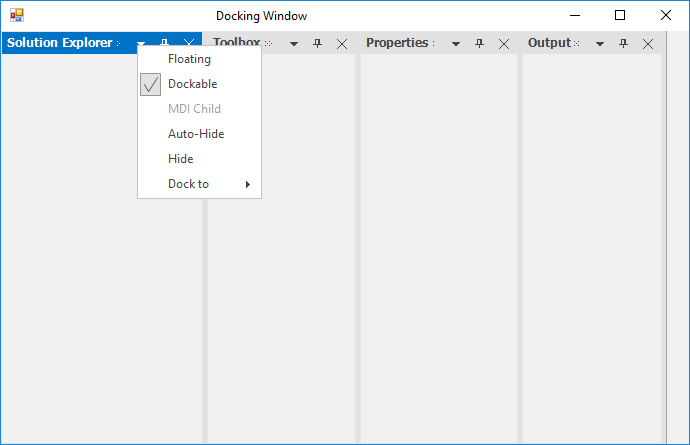
NOTE
If the
MDIContainerproperty of the form is set totrue, then the context menu will include MDI child option.

Remove specific default menu item from context menu
Context menu items in the dock window caption can be customized using the DockContextMenu event of the docking manager. The DockContextMenuEventArgs allows to remove the menu items using its ContextMenu option. So, you can add/remove the ContextMenuItem by passing the corresponding BarItem to add/remove function.
The following code example demonstrates removing the default menu items such as “Hide” and “Dock to”. The ContextMenuItemText is used to remove the default menu items from the context menu.
| ContextMenuItem | Corresponding BarItem text |
|---|---|
| Floating | &Floating |
| Dockable | Doc&kable |
| MDI Child | &MDI Child |
| Auto-Hide | &Auto-Hide |
| Hide | &Hide |
| Dock to | Dock to |
// Remove ContextMenuItem
this.dockingManager1.DockContextMenu += DockingManager1_DockContextMenu;
private void DockingManager1_DockContextMenu(object sender, DockContextMenuEventArgs arg)
{
BarItem item = arg.ContextMenu.ParentBarItem.Items[4] as BarItem;
BarItem item1 = arg.ContextMenu.ParentBarItem.Items[5] as BarItem;
if (item != null && item.Text == "&Hide")
{
arg.ContextMenu.ParentBarItem.Items.Remove(item);
}
if (item1 != null && item1.Text == "Dock to")
{
arg.ContextMenu.ParentBarItem.Items.Remove(item1);
}
}AddHandler Me.dockingManager1.DockContextMenu, AddressOf DockingManager1_DockContextMenu
'Remove ContextMenuItem
Dim item As BarItem = TryCast(arg.ContextMenu.ParentBarItem.Items(4), BarItem)
Dim item1 As BarItem = TryCast(arg.ContextMenu.ParentBarItem.Items(5), BarItem)
If item IsNot Nothing AndAlso item.Text = "&Hide" Then
arg.ContextMenu.ParentBarItem.Items.Remove(item)
End If
If item1 IsNot Nothing AndAlso item1.Text = "Dock to" Then
arg.ContextMenu.ParentBarItem.Items.Remove(item1)
End If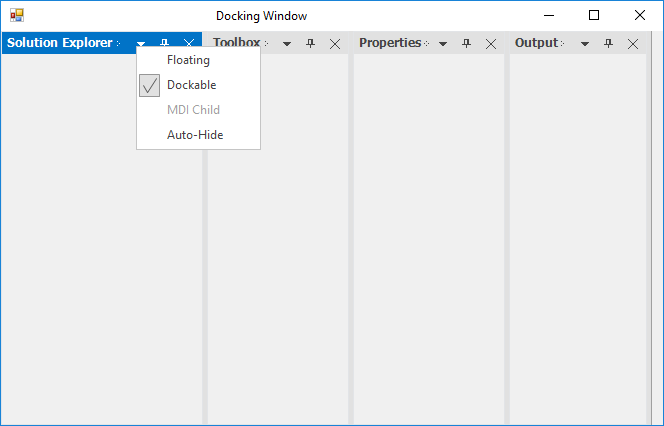
Restrict resize
The docking manager provides option to restrict user for resizing the dock panel to specified minimum size. The SetControlMinimumSize function helps to set the minimum size of docked control.
//Set the minimum size of docked control using the SetControlMinimumSize method
this.dockingManager1.SetControlMinimumSize(panel1,new Size(200, 400));'Set the minimum size of docked control using the SetControlMinimumSize method
Me.dockingManager1.SetControlMinimumSize(panel1,new Size(200, 400))Restrict to resize specific window
FreezeResizing function helps to restrict the sizing of docking child windows.
this.dockingManager1.FreezeResizing = true;Me.dockingManager1.FreezeResizing = TrueCustomize resize splitter
The splitter of the dock window can be customized using the SplitterWidth and MetroSplitterBackColor properties depends upon its values respectively.
this.dockingManager1.SplitterWidth = 10;
this.dockingManager1.MetroSplitterBackColor = Color.Red;Me.dockingManager1.SplitterWidth = 10
Me.dockingManager1.MetroSplitterBackColor = Color.Red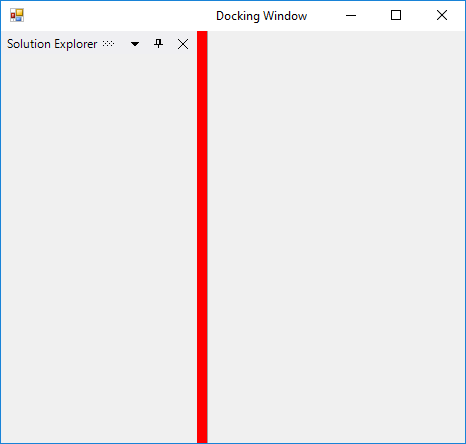
NOTE
The MetroSplitterBackColor property effects only when the DockingManager.VisualStyle property is set to Metro.